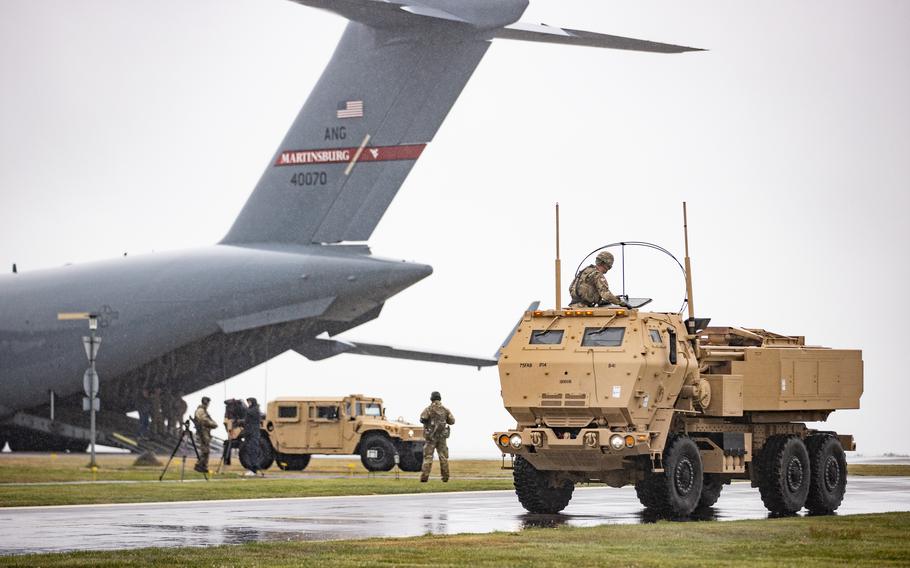
U.S. soldiers assigned to Bravo Battery, 1st Battalion, 14th Field Artillery Regiment, 75th Artillery Brigade and U.S. airmen assigned to the 167th Airlift Wing of the West Virginia Air National Guard unload and employ a High Mobility Multipurpose Wheeled Vehicle and a M142 High Mobility Artillery Rocket System during an exercise in Bornholm, Denmark, on May 24, 2022. (Capt. Angelo Mejia/U.S. Army Photo)
WASHINGTON — Four medium-range rocket systems will be included in the latest $700 million U.S. military aid package after continued calls by Ukrainian officials for the weapons, Undersecretary of Defense for Policy Colin Kahl said Wednesday.
The High Mobility Artillery Rocket Systems, or HIMARS, can strike targets roughly 50 miles away and are expected to help “provide Ukraine additional precision in targeting at [a longer] range,” Kahl told reporters at the Pentagon.
By comparison, the M777 howitzer, the last significant artillery system that the U.S. provided Ukraine, has a maximum range of 15 miles. The U.S. has sent approximately 108 of those 155mm cannons to Ukraine since April.
Kahl said the rockets were the Ukrainians’ top request in discussions about the weapons that they need to beat back Russian forces on the battlefield.
The weapons and equipment in the latest aid package also includes four Mi-17 helicopters, 15 tactical vehicles, five counter-artillery radars, two air surveillance radars, 1,000 Javelin missiles, 6,000 anti-armor weapons, 15,000 155mm artillery rounds and “various spare parts,” Kahl said.
"Right now, it's a concentrated artillery duel in the east,” he said of the war that’s now focused in the Donbas region of eastern Ukraine. “In the last several days, the Russians have made some incremental progress in and around the Donbas. They have not had a decisive breakthrough, and the Ukrainians are putting up a heck of a fight."
The aid package announced Wednesday will be the first to come from the new $40 billion supplemental funding approved by Congress on May 19, which allotted about $11 billion for military aid for Ukraine.
“Thanks to the additional funding for Ukraine, passed with overwhelmingly bipartisan support in the U.S. Congress, the United States will be able to keep providing Ukraine with more of the weapons that they are using so effectively to repel Russian attacks,” President Joe Biden said in a statement announcing the additional aid.
While the inclusion of the rockets is significant, Kahl warned “no system is going to turn the war.”
“This is a battle of national will. You have tens of thousands, hundreds of thousands of men ... on each side,” he said. “It is a grinding, hard conflict and it's likely to be a conflict … that will stretch on for a long time."
In exchange for the rockets, Ukrainian officials promised U.S. officials that they would only use the HIMARS for defensive purposes and not target Russian territory to avoid further escalation in the war, Kahl said.
"Ukraine is defending their territory, anything they're doing on the territory of Ukraine is defensive,” he said.
Some critics have said sending advanced weapons to Ukraine could further provoke Russia’s aggression, which Kahl said the Biden administration takes into consideration.
“President Biden has made clear, we have no intention of coming into direct conflict with Russia, we don't have an interest in the conflict in Ukraine widening to broader conflict or evolving into World War III,” Kahl said. “But at the same time, Russia doesn't get a veto over what we send to the Ukrainians.”
The four rocket systems had already been prepositioned in undisclosed European nations outside Ukraine. They will remain there before entering the fight as Ukrainian forces undergo training on the systems, which should take about three weeks, he said.
“Sometime in that timeframe you can start talking about getting the systems into the fire,” Kahl said.
The U.S. could send additional rocket systems and ammunitions in the future should it be necessary, he said.
“I think we need to see this kind of as a rolling process,” Kahl said. “As the fight continues to change, the Ukrainians come to us with their priorities [and] we make our own assessments."
With the latest announcement, the U.S. has committed roughly $5.3 billion in military aid to Ukraine since the beginning of the Biden administration — about $4.6 billion of which was sent since Russia invaded Ukraine on Feb. 24, according to the Pentagon.